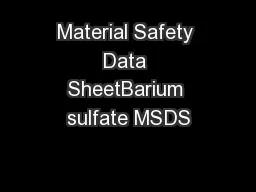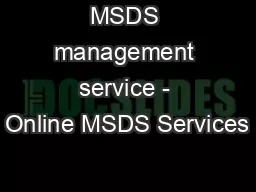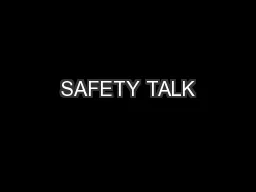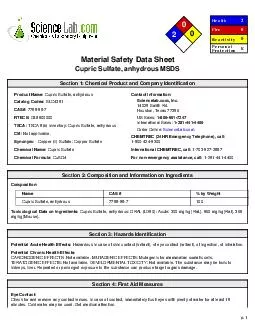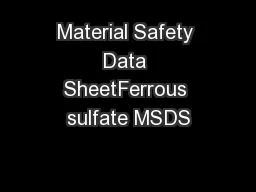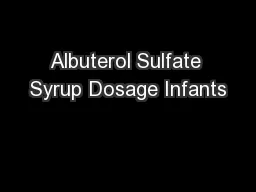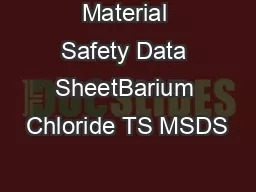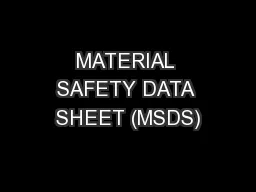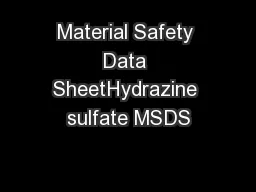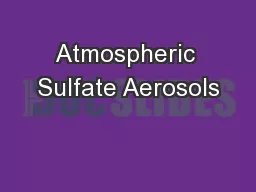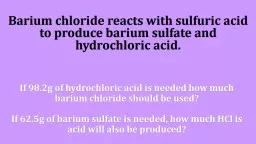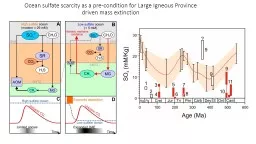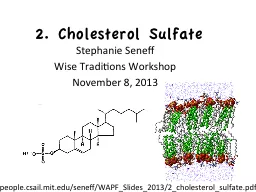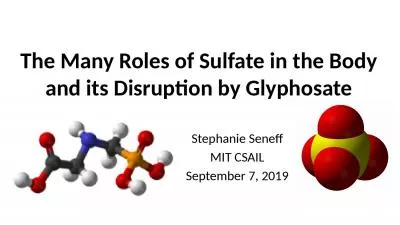PDF-Material Safety Data SheetBarium sulfate MSDS
Author : alida-meadow | Published Date : 2016-03-02
p 1 0 1 0 Health Fire Reactivity Personal Protection 1 0 0 E Section 1 Chemical Product and Company Identification Product Name Barium sulfateCatalog Codes SLB3148
Presentation Embed Code
Download Presentation
Download Presentation The PPT/PDF document "Material Safety Data SheetBarium sulfate..." is the property of its rightful owner. Permission is granted to download and print the materials on this website for personal, non-commercial use only, and to display it on your personal computer provided you do not modify the materials and that you retain all copyright notices contained in the materials. By downloading content from our website, you accept the terms of this agreement.
Material Safety Data SheetBarium sulfate MSDS: Transcript
p 1 0 1 0 Health Fire Reactivity Personal Protection 1 0 0 E Section 1 Chemical Product and Company Identification Product Name Barium sulfateCatalog Codes SLB3148 SLB4648CAS 7727437RTECS CR. http://www.msdssource.com - MSDSSource.com is the leading provider of Online MSDS Services. Our customized sites create safer work environments, save time and help lower costs. Let us handle your MSDS Management Service today! http://www.msdssource.com MSDSSource.com is the leading provider of Online MSDS Services. Our customized sites create safer work environments, save time and help lower costs. Let us handle your MSDS Management Service today! Hazardous Communication #2. The hazardous communication standard uses two primary ways to communicate the chemical hazards to the employees: the label on the chemical container and the material safety data sheet (MSDS) or safety data sheet (SDS) as GHS is phased in. The following Safety . p. 1 0 2 0 Health Fire Reactivity Personal 2 0 0 E Section 1: Chemical Product and Company Identification Product Name: Cupric Sulfate, anhydrousCatalog Codes: SLC4351CAS#: 7758-98-7RTECS: GL8800000TS p. 1 0 2 0 Health Fire Reactivity Personal Protection 2 0 0 E Section 1: Chemical Product and Company Identification Product Name: Ferrous sulfateCatalog Codes: SLF1516CAS#: 13463-43-9RTECS: Not avail combivent monodosis para nebulizacion. albuterol sulfate syrup dosage for toddlers. albuterol sulfate 0.083 price. is there a generic combivent inhaler. albuterol sulfate nebulizer uses. combivent inhaler dosage. p. 1 0 2 0 Health Fire Reactivity Personal Protection 2 0 0 G Section 1: Chemical Product and Company Identification Product Name: Barium Chloride TSCatalog Codes: SLB2362CAS#: Mixture.RTECS: Not appl BUTANE Please ensure that this MSDS is received by an appropriate person DATE: M ay 2015 Version 3 Page 1 of 3 Ref. No.: MS088 AFROX is a member of The Linde p. 1 1 3 0 Health Fire Reactivity Personal Protection 3 1 0 J Section 1: Chemical Product and Company Identification Product Name: Hydrazine sulfateCatalog Codes: SLH1291CAS#: 10034-93-2RTECS: MV9625 By: John Joseph, Justin Hicks, and Daniel Silberstein. Overview. Scattering. : the deflection of radiation by particles in the atmosphere . Solar (shortwave) radiation. : the radiation that makes its way into the Earth’s atmosphere in the form of UV and visible waves. If 98.2g . of hydrochloric acid is needed how much barium chloride should be used?. If 62.5g of barium sulfate is needed, how much . HCl. is acid will also be produced?. Barium chloride reacts with sulfuric acid to produce barium sulfate and hydrochloric acid. . extinction . Rob Newton. , Tianchen He, Jacopo Dal Corso, Paul . Wignall. , Ben Mills, Alex . Dunhill. Highlighting an idea presented in:. He et al., . 2020. . Science Advances. DOI: 10.1126/sciadv.abb6704. Wise Traditions Workshop. November 8, 2013. p. eople.csail.mit.edu. /. seneff. /WAPF_Slides_2013/2_cholesterol_sulfate.pdf. . ”If we all worked on the assumption that what is accepted as true is really true, there would be little hope of advance.. Stephanie Seneff. MIT CSAIL. September 7, 2019. Outline. Sulfate and the . Glycocalyx. Cholesterol Sulfate and Heart Disease. Glyphosate as a Glycine Analogue. Endothelial Nitric Oxide Synthase: a Moonlighting Enzyme.
Download Document
Here is the link to download the presentation.
"Material Safety Data SheetBarium sulfate MSDS"The content belongs to its owner. You may download and print it for personal use, without modification, and keep all copyright notices. By downloading, you agree to these terms.
Related Documents

